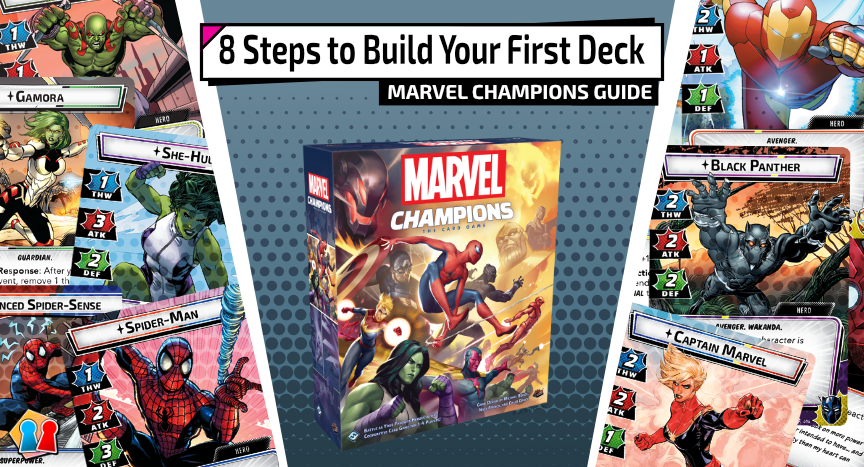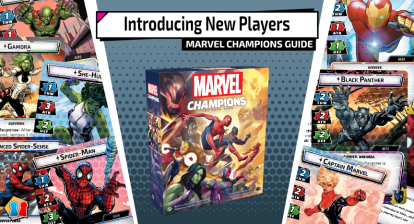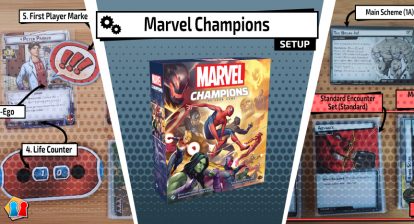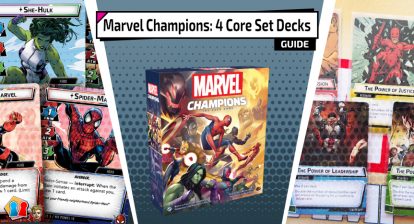Deckbuilding is one of those things that seems intimidating when you first get started with a game like Marvel Champions, but is actually really important and nowhere near as difficult as you might think. If you want to take on the hardest challenges, and most importantly have the most fun with the game, you’re going to have to give it a shot eventually.
That’s why in this short article, I’m going to show you the very basics of how to put together a deck, step by step, and what you should look out for when you give it a go yourself. But first, a disclaimer. This won’t result in the world’s greatest deck, not everything I say will be true in every situation or work against every possible villain. The intent of this little article is to simply demystify the process for beginners who find the deckbuilding half of Marvel Champions (and it may as well be half the game) intimidating.
1. Pick who you want to play
For most people, the starting point for building your deck is going to be “I want to play [blank]”. Technically speaking, a better question to ask is “Who is the best hero to fulfil this role?”, but again, we’re not going super in-depth here. The much more common use case is that you have your heroes and you want to build a deck for your favourite. That’s totally fine, so let’s do that.
2. Work out what they’re good at
This part’s a bit trickier. You need to look at the hero, their stats, and what cards they’ve got available to them. Generally almost everything that you can do in the game falls into a few very similar buckets, which actually roughly map to the attributes of our heroes and their aspects:
- Attacking the villain and/or minions
- Defending people/yourself from losing the game (either preventing damage, healing, or stopping another game-losing event from happening, such as cancelling treacheries or inflicting conditions on the villain)
- Thwarting the main scheme and/or side schemes
- Providing resources (cards, literal resources for paying for cards, or situational resources)
While there are edge cases, weird cards and combinations, pretty much every card effect or action will do one or more of those things.
Let’s pick a great character from the base game – Captain Marvel (Core Set #10). Carol Danvers is a real powerhouse that we’ve only really gone back to appreciate recently. Her hero deck consists of the following cards, which I’ve quickly divided into our groupings for easy analysis:
| Attack | Defend
|
| Thwart | Resource
|
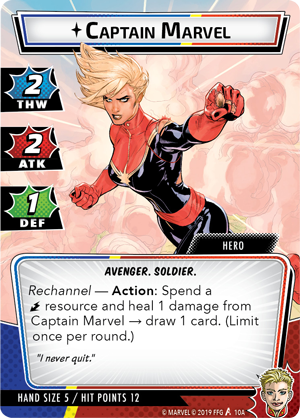
As you can see, I’ve put Spider-Woman under defend. That might seem confusing, but look at it this way. Spider-Woman can attack or thwart equally well, so she doesn’t really fall in either category. Her health is low, so you don’t get many uses of those powers out of her before she heads off to discard, and she has a response to being played. This means that most of the time your best bet is to play her, use a single use of her power and then immediately throw her under the bus to block the villain’s next attack to get her back faster for a fresh Confuse. That’s why I typically put most Allies under the “defend” column, though there are many exceptions to this with other heroes and allies, so make sure you always rate each Ally independently. In this case, her biggest contribution is the confusion status and block, so she gets a defence classification for the sake of simplicity.
We can see here that Captain Marvel is relatively balanced in what she’s good at. This is true of most characters (intentionally so), but some cards are definitely better than others. In particular we need to pay a lot of attention to her hero and alter ego actions, as we’re going to have access to one or the other 100% of the time.
I’ll save the card by card analysis for another time, but here’s my summary of Captain Marvel based on looking at her identity and hero cards.
- She gets crazy good resources, and can stay in hero form for a long time thanks to her defensive cards, base health, and healing ability in hero form. Defensively, she’s a powerhouse, especially as when she *does* flip, she doesn’t have to spend a long time in alter-ego, due to her high recovery
- Offensively, she can do a fair chunk of damage. But Photonic Blast isn’t as big a nuke as some other characters (for example Scarlet Witch’s Molecular Decay will almost always do more damage), and while Energy Channel does a ton of damage, you have to invest quite a lot of specific resources to do it.
- Her thwarting cards are probably her worst cards, and she has the least thwarting power, but they’re good for removing side schemes
- She doesn’t have a way to ready herself, so cards that rely on using basic hero powers aren’t a great choice for her
- Her resource generation is absolutely bananas. 3 resources from a single card? The ability to keep drawing cards in either form? Oh boy.
In summary, she’s a decent all-rounder who can take a beating and pay for some super expensive cards. This is information we’ll need later.
Despite all that text, evaluating cards and what heroes are good at is a skill that you can only really develop by doing it. Don’t be afraid to make mistakes, just give it a shot and take a moment to look at some of your favourite heroes and analyse them.
3. Add the Staples
While this isn’t true in every case, and you’ll want to refine this as you get more experience building decks, there are certain basic cards that almost every deck will include. Before you have to make any difficult decisions, it’s worth getting those cards in right away. These cards are:
- The basic resources: Energy, Strength, and Genius
- Avenger’s Mansion – Especially effective in multiplayer as you can allow anyone to draw, but in general drawing cards is always the most powerful thing you can do in a card game
- Nick Fury – A powerful draw effect to get through your deck, a good statline and a blocked attack? There are few cards better to drop a huge amount of resources on
- Quincarrier – Just an insane amount of resource generation
It’s worth noting that only one person can have the Quincarrier in play, so you want to coordinate this with the rest of your team. To make this easy – whoever has a specific resource requirement should be the person who gets the Quincarrier. If multiple players have the Quincarrier, look who has the best resource-specific cards and abilities. In Captain Marvel’s case, she’s a fantastic choice for the Quincarrier because she can always use the one specific energy resource to trigger her hero ability.
If you’re not the best person to get the Quincarrier, or you simply don’t own a copy, just swap it out for a Helicarrier instead. Quincarrier is an outright better card in almost every situation, but the unique rule is what it is.
Then there’s a couple of other cards that we always check to include – these are less automatic inclusions than the others, but you want to look at your hero and decide what you need. If you’re not sure, include them anyway (provided you own them):
- Endurance – If your hero has 10 or less health, include it. Gaining 3 health is a lot more impactful than you might think, and reduces the odds of you accidentally getting murdered in a single round.
- Down Time – Only a few characters don’t need this, but generally if you only have 3 recovery it’s worth considering. Even if you have more (as with Captain Marvel), it’s normally worth putting in unless you’re playing the tankiest, most unkillable heroes.
- Helicarrier – Yeah, I mentioned this one already, but technically there’s nothing stopping you running this and a Quincarrier, plus it can be used to help your friends if you’re playing multiplayer. That can be a bit excessive, but it’s definitely worth considering.
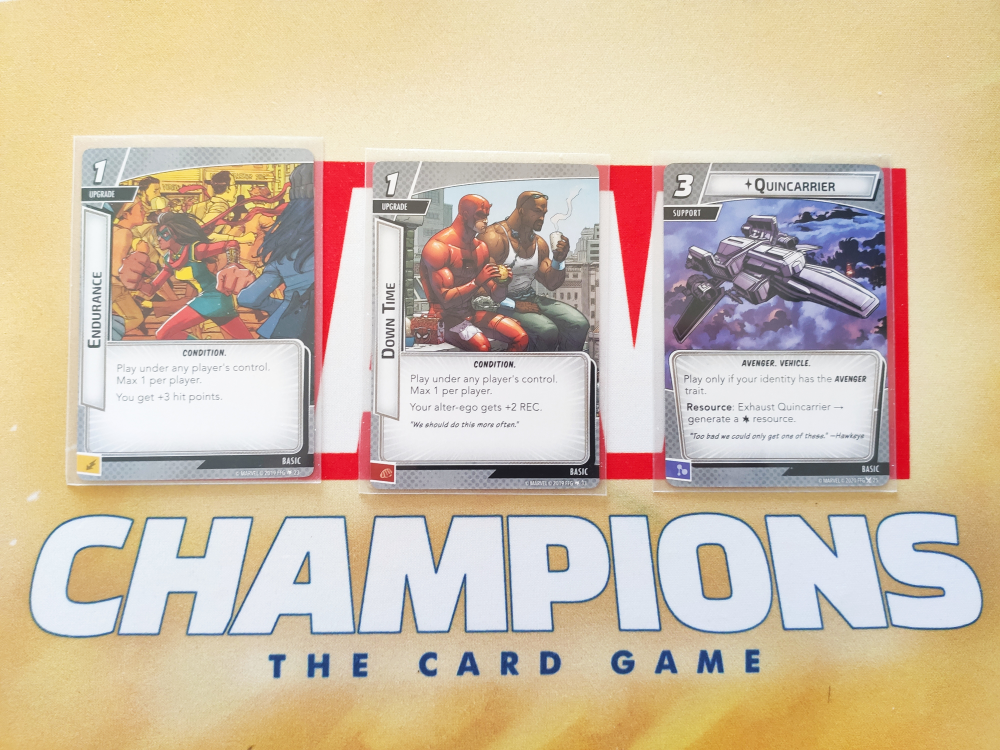
Hey look, if you take all of those you’re already at 23 cards! Your deck is over half done and you’ve not really had to make any hard decisions yet.
4. Choose what to lean into (AKA your aspect)
Now that you’ve got your hero and have spent a little bit looking at what they’re good at, and have reduced your choices, it’s time to start thinking about the hard part that comes next. There’s two ways you can go with your deck, and you should decide this before you even start thinking about what cards to add. Do you want to:
- Do what your hero is already good at, and become a specialist
OR
- Rely on the hero’s strength, and focus your build around their weakest parts in order to round them out as a strong all-rounder

This decision is actually not as hard as you might think, and it’s mostly about how you intend to play. Are you in a 4-player team? Then you should probably specialise in whatever job you’re doing. If you’re in a group of 4 players, you’re best off having people who are focused on what their job is. If you’re the side scheme guy, be the side scheme guy – if you fail at your role, you’re going to let your team down. But if you’re playing solo or duo, you’re normally best off being at least a little general in your focus.
In our case, we always play two-player, so while a little specialising is necessary (and inevitable), we like to round out our choices and lean into where the character is weakest unless there’s an obvious synergy that the character is built for (such as Star-Lord’s obvious Leadership qualities). This means in this case, we actually prefer to play Captain Marvel as Justice. Her thwarting is her weakest trait when you take into account her cards and abilities, but add powerful thwarting cards from justice and her weaknesses are effectively eradicated, making her a powerful all-rounder with a focus on dealing with threat. Her ability to remain in hero form for a long time effectively gives her a passive threat reduction, because you flip to Alter-Ego a lot less often than you would need to with a squisher character.
If we were playing 4-player, instead we’d probably play Captain Marvel as Leadership. While her defensive abilities are nothing to sniff at, her resource generation is off the charts, and Leadership can do a lot when given ample resources, due to how powerful high-cost minions and upgrades can be.
5. Add some allies
It’s easy to underrate allies, but they really are some of the strongest cards you can add to your deck. Let’s take Mockingbird as an example. She’s one of the allies I will almost always consider adding to a deck. This isn’t always true, which is the reason she’s not up in the staples, but it’s close.
For 3 resources you get:
- Up to 2 activations (2 thwart, 2 damage or one of each)
- A stun on entry that prevents an attack
- A block that prevents an attack
That’s… some good value. To put it another way, that’s effectively very similar to Webbed Up, one of Spider-Man’s strongest hero cards, in that it can fairly reliably (overkill permitting) prevent 2 entire villain activations. This gives you a ton of room to do whatever your hero does. Allies are typically used for their abilities, their basic thwart and attack (sometimes just once if the situation demands it), and then to block an attack.
In general, I would almost always add at least ~5 allies as a general rule of thumb, including Nick Fury, who we added already. Try to keep them on the cheap side of things (3 cost unless they’re really good), because unless you’re playing Leadership (which by the way, increases the number of allies you should be playing to 8-10 allies), you’ll probably not be keeping them in play for long.
By this point, your deck’s up to ~28 cards – that’s 12 to go!

6. Add upgrades, resources, and events
This is where things get a bit looser, and harder, because we’re not building a specific deck here, and what proportion of these you use is going to be different depending on what you play, but this is essentially the rest of your deck.
Here’s a few rules of thumb to look for:
- If you’re playing Aggression or Justice, include at least 8 events that do your job – that’s clearing schemes and defeating minions.
- Aggression, Justice, and Protection also have upgrades that increase your basic attributes by 1 depending on which aspect you are. These are almost always worthwhile unless your hero tends to exhaust themselves to use their abilities (such as Ms. Marvel or Doctor Strange). If you’re playing with a friend who can ready themselves repeatedly (Quicksilver in particular), bring a copy for them as well – you can play them under the control of other players!
- If you’re playing Protection multiplayer, being able to ready your hero is invaluable for making sure you’re able to defend your friends.
If you’re playing Leadership and you own it, Team Building Exercise is a great way to speed up playing your allies. You may also want some cards that increase your ally capacity, like the Triskelion, but only if your deck is heavy on cheap allies. - Any card that draws cards is almost always good. Card draw is the most powerful thing you can add to your deck.
You also may find yourself wanting some extra resources. If you look at your “definitely” pile and see that most of your cards are 3+ cost, you’ll want to include something like the Power of ___ cards, like the Power of Justice. If you regularly need a specific resource, you may instead want to include a card like Enhanced Awareness, Enhanced Reflexes, or Enhance Physique. Heroes like Iron Man, who always needs a tech resource to go aerial, benefit hugely from those reliable resource generators, so don’t be afraid to put one or two copies into your deck.
Don’t get too hung up on this part, go through your cards and pile up the ones that you definitely want to include in your deck, the ones you think look interesting, and the ones you have no interest in. You can put that last pile back in the box.
Next grab the maximum number of copies of every card from your “definitely” pile together. This probably leaves you with way too many cards. If not, pick the best ones from your “maybe” pile and throw them in too.
If you’re anything like me, your deck is now about 172 cards tall. The minimum legal size is 40 and the maximum is 50, so it’s cutting time.
7. Cut some cards
This is the hardest part. Be absolutely brutal and start removing cards. Consider how many copies you need of a card. If you’ll always play it the moment it hits your hand (and it’s not unique or limited), keep 3 copies in your deck. If not, cut that down to 2. If you won’t play it more often than you want to play it, then take it out entirely. Only go down to 1 copy of a card if you literally cannot play 2 (due to uniqueness or similar). If it’s worth including 1 and you can play more, then it’s worth including 2 in 99% of cases.
Consider which cards are too expensive and look at them comparatively. If in doubt, take a card that costs 2 over a card that costs more and does the same thing. To put it incredibly simplistically, if you have 6 cards in hand, you can play 2 cards that cost 2 resources, but you can’t play 2 cards that cost 3 resources (because the card itself is also no longer available). When you play a 3 resource-cost card, chances are you’ll have a hand size of 5, which means at best you can play a second card that costs 0. That’s almost always worse than two 2-cost cards.
Keep on cutting until you get as close to 40 cards as possible. But why 40? Isn’t 50 the maximum?
The reason we shoot for 40 cards is because every hero has a few powerful cards we want to get into our hands as soon as possible. Captain Marvel, for example, has huge resources that can play huge cards that you typically only have one copy of in your deck. Spider-Man has web shooters, Iron Man has his armour. These things are better than anything else in your deck, and you want to get to them as soon as possible. With 50 cards, you will have lower odds of drawing any particular card you want in any given circumstances.
To put it another way, if there are 50 cards in your deck and you draw your starting hand of 6 cards, you have a 6/50 cards (or 12%) chance of drawing one specific card. If you have 40 cards, you have a 6/40 (which clocks in at 15%) chance at drawing that card. This doesn’t sound like a lot, but you’re essentially playing those odds every time you draw a card for turn or from your actions. The effect of cutting those 10 cards will have a noticeable effect on your deck’s power.
But let’s say you’re not sure what to play and what to cut. Not everyone can look at a card and immediately ascertain it’s value, and if you think you can do that without experience you’re either wrong or a god of card games. I doubt it’s the latter. You may want to consider looking at some existing decklists on the Marvel CDB Hall of Fame. That’s a good way to make a decision around which cards to keep, because chances are they picked some good cards, but be aware that a lot of those decks are based around extremely specific combos. A card that works in their deck might not work in yours.
Just do your best, and if your deck ends up anywhere between 40 and 50 cards that’s totally fine. The final step of this process is still to come and it’s the most important one of all.
8. Iterate
Iterate, iterate, iterate. Literally nobody who builds good decks does so without testing. Play Marvel Champions with your deck. Play games. See what happens. See which cards you wish you had, and which cards you’re disappointed by. Play more than once to make sure that whatever your deck did or didn’t do is just a fluke. Our favourite villains for testing include:
- Klaw (Core Set) – Extremely high damage and threat output, good for testing survivability and thwarting potential.
- Green Goblin (Mutagen Formula) (Green Goblin Expansion) – Minion central, with chunky other stats as well
- Drang (Galaxy’s Most Wanted Expansion) – High damage output, high threat, and tons of side-schemes, probably the best all-round villain for high tier general deck testing
Keep on iterating until you feel your deck is the best version of what you were trying to do… and then build more decks once you get tired of it! That’s the fun of deck building in Marvel Champions, you’re never done. If you get addicted enough to it, playing the game becomes more about what challenges you can pose for your decks than playing the game itself.
Hopefully, this has made you feel a bit more relaxed about the prospect of building your own first deck. If you use this to come up with a deck that works for you, we’d love to hear about it! Tweet it to us over at @cardboardchamps on Twitter.

